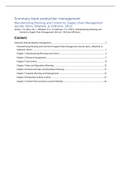Samenvatting
Summary book production management Manufacturing Planning and Control for Supply Chain Management
- Instelling
- Tilburg University (UVT)
This is a summary of the relevant chapters for the Production Management course in spring 2021. Most relevant theory is summarized for this course.
[Meer zien]













